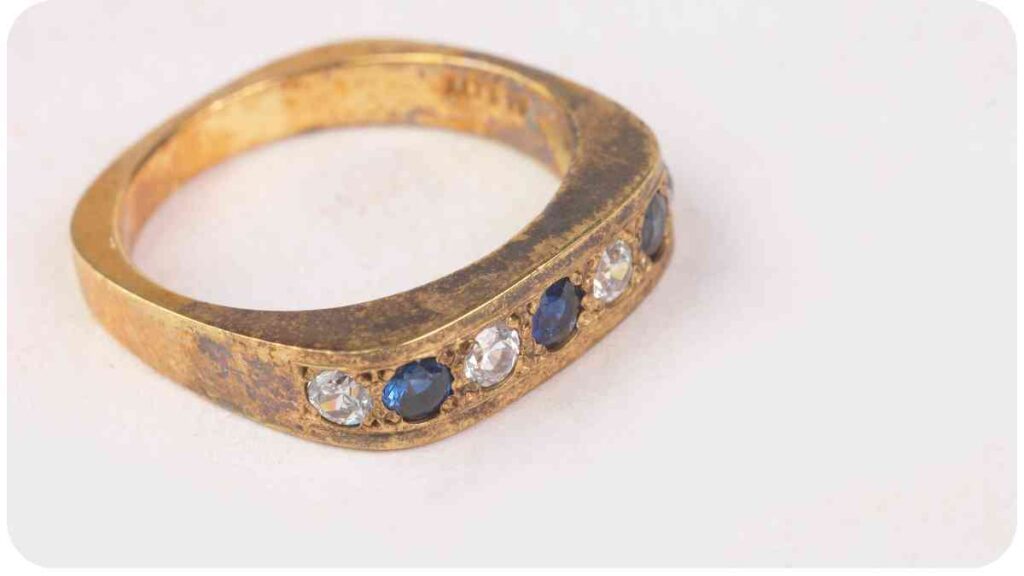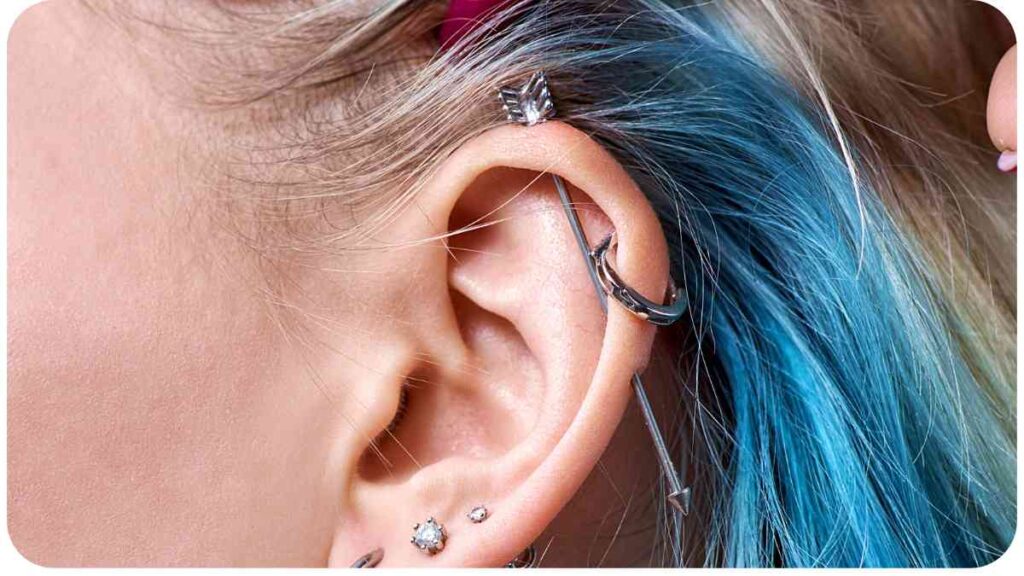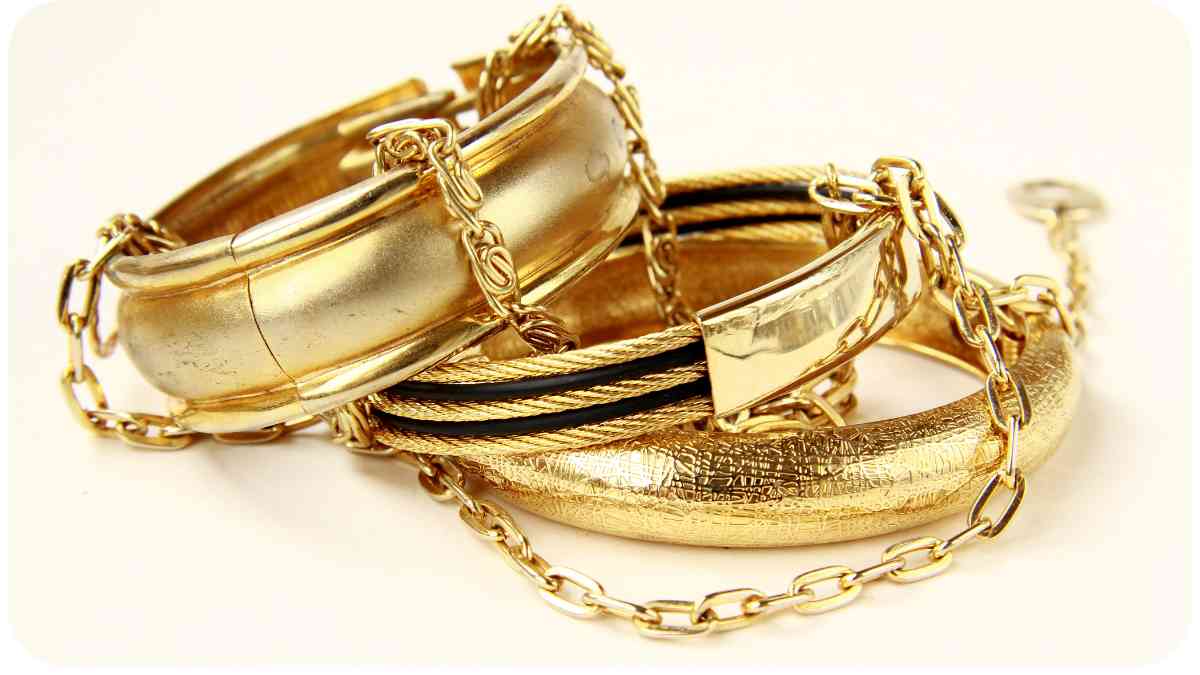Welcome to this comprehensive guide on why earrings turn green and how you can prevent jewelry tarnish. If you’ve ever experienced the frustration of your favorite earrings leaving a green mark on your skin, you’re not alone. Understanding the causes of tarnish and knowing how to care for your jewelry can help you enjoy your pieces for a long time without any unsightly discoloration.
In this article, we will delve into the reasons behind green earrings, explore different metals and their tendencies to tarnish, discuss factors that accelerate tarnishing, provide tips to prevent earrings from turning green, share effective cleaning methods, and even offer alternative options to avoid tarnishing altogether.
We’ll cover everything you need to know to keep your earrings looking beautiful and avoid any unpleasant surprises. Let’s get started!
| Takeaways |
| Understand the causes of earring tarnish and why they turn green. |
| Different metals have varying tendencies to tarnish. |
| Factors such as moisture, chemicals, and pH levels can accelerate tarnishing. |
| Proper storage and regular cleaning can help prevent earrings from turning green. |
| Consider non-tarnish metals like titanium, stainless steel, and platinum for earrings. |
2. What Causes Earrings to Turn Green
Green earrings are a result of tarnishing, which occurs when the metal of the earrings oxidizes. There are several common causes for this phenomenon, as shown in the table below.
Table 1: Common Causes of Green Earrings
| Cause | Explanation |
| Moisture | Exposure to moisture, such as sweat or humidity, can accelerate the oxidization process. |
| Chemicals | Contact with certain chemicals, such as chlorine in swimming pools or perfumes, can cause tarnish. |
| pH Level of Skin | Individual variations in skin pH levels can react differently with metals, causing tarnish. |
| Reaction with Airborne Sulfur Compounds | Airborne pollutants containing sulfur compounds can react with metals, resulting in tarnish. |
| Low-Quality Plating or Cheap Metal | Inexpensive jewelry may have poor-quality plating or be made of cheap metals, which can tarnish more easily. |
Understanding these causes will help you address the issue and take preventive measures. Now, let’s discuss the role of metal types in jewelry tarnish.
Wondering why your silver jewelry loses its shine? Learn more about silver jewelry tarnish and explore effective cleaning techniques to maintain its luster. Understanding the causes behind tarnishing helps you preserve the beauty of your cherished pieces.
3. The Role of Metal Types
The type of metal used in your earrings plays a significant role in their susceptibility to tarnishing. Different metals exhibit varying levels of resistance to oxidation and tarnish. Refer to the table below for a comparison.
Table 2: Metal Types and Their Tendency to Tarnish
| Metal | Tendency to Tarnish |
| Sterling Silver | High |
| Brass | High |
| Copper | High |
| Gold-Filled | Low |
| Stainless Steel | Low |
| Titanium | Low |
| Platinum | Highly resistant |
As you can see, metals like sterling silver, brass, and copper have a tendency to tarnish more easily compared to gold-filled, stainless steel, titanium, and platinum.
Remember, the choice of metal when purchasing earrings can significantly impact their longevity and resistance to tarnish. Now, let’s explore the various factors that can accelerate tarnishing.
4. Factors That Affect Tarnishing
In addition to the type of metal used, there are other factors that can contribute to the tarnishing process. By understanding these factors, you can take appropriate measures to minimize tarnish and keep your earrings looking their best. Refer to the table below for an overview.
Are you concerned about your fragrances in varying temperatures? Understand the impact of temperature on fragrances and ensure their longevity. Discover how heat influences perfume compositions and learn valuable tips to store your favorite scents appropriately.
Table 3: Factors That Accelerate Jewelry Tarnish

| Factors | Explanation |
| Humidity and Moisture | High humidity levels and exposure to moisture can speed up the oxidization process, leading to tarnish. |
| Acidic Skin | Individuals with acidic skin pH levels are more prone to tarnishing, as the acid can react with metals. |
| Chemical Exposure | Contact with chemicals like lotions, perfumes, and cleaning agents can accelerate the tarnishing process. |
| Sweat | Sweat contains salt and compounds that can facilitate the tarnishing of earrings. |
| Airborne Pollutants and |
Table 3: Factors That Accelerate Jewelry Tarnish (continued)
| Factors | Explanation |
| Airborne Pollutants and Sulphur | Air pollution, particularly in urban areas, often contains sulphur compounds that can cause tarnish. |
| Light Exposure | Prolonged exposure to sunlight or artificial light can speed up the tarnishing process. |
| Storage Conditions | Improper storage, such as keeping earrings in humid areas or with other tarnish-prone jewelry, can worsen tarnish. |
It’s important to be aware of these factors and take steps to minimize their impact on the longevity of your earrings. Now, let’s move on to discussing preventive measures to keep your earrings from turning green.
Uncover the skincare mistake that may be damaging your skin’s health. Identify common errors and learn how to avoid them, promoting a radiant complexion. Discover the right skincare practices and products, empowering you to maintain healthy, glowing skin effortlessly.
5. Preventing Earrings from Turning Green
While tarnishing is a natural process, there are steps you can take to slow it down and minimize the green discoloration of your earrings. Refer to the table below for helpful tips in preventing tarnish.
Table 4: Tips to Prevent Earrings from Tarnishing
| Preventive Measures | Explanation |
| Remove Earrings When Engaging in Certain Activities | Take off your earrings before swimming, exercising, or applying lotions or perfumes to minimize tarnish. |
| Store Earrings in a Dry Environment | Keep your earrings in a jewelry box or airtight container to protect them from moisture and humidity. |
| Avoid Storing with Other Tarnish-Prone Jewelry | Certain metals and materials can accelerate tarnish, so store your earrings separately to prevent contact. |
| Clean Earrings Regularly | Regular cleaning removes oils, sweat, and other substances that can contribute to tarnishing. |
| Utilize Anti-Tarnish Strips or Pouches | These strips or pouches can absorb moisture and chemicals, providing an extra layer of protection. |
By following these preventive measures, you can significantly reduce the likelihood of your earrings turning green. However, it’s essential to keep in mind that even with the best care, some tarnish may still occur over time. In such cases, cleaning and maintenance are key.
6. Cleaning and Maintaining Your Earrings

Regular cleaning and maintenance are crucial to keep your earrings looking their best. However, it’s important to use appropriate cleaning methods based on the material of your earrings. Refer to the table below for cleaning methods tailored to different earring materials.
Dry shampoo can be a lifesaver, but do you know the pros and cons of dry shampoo? Explore its benefits and potential drawbacks, enabling you to make informed choices. Discover the secrets behind this convenient hair care product and how it fits into your routine.
Table 5: Cleaning Methods for Different Earring Materials
| Earring Materials | Cleaning Methods |
| Sterling Silver | Use a silver polishing cloth or gentle silver cleaning solution. |
| Brass and Copper | Mix lemon juice with water or create a paste with vinegar and salt. |
| Gold-Filled | Clean with a soft cloth or mild soap and water; avoid harsh chemicals. |
| Stainless Steel | Wipe with a damp cloth and mild detergent; dry thoroughly. |
| Titanium | Gently clean with mild soap and water using a soft cloth. |
| Platinum | Soak in warm soapy water and scrub gently with a soft brush. |
Remember to handle your earrings with care during the cleaning process, and avoid using abrasive materials that could scratch or damage them. Following these cleaning methods will help restore the shine and remove any tarnish that has accumulated.
7. Alternative Options to Avoid Tarnishing
If you are particularly concerned about tarnish and want to avoid it altogether, there are alternative options for earrings that are less prone to tarnishing. Consider the following non-tarnish metals:
Table 6: Non-Tarnish Metals for Earrings
| Non-Tarnish Metals | Benefits |
| Titanium | Lightweight, hypoallergenic, durable |
| Stainless Steel | Sturdy, affordable, low-maintenance |
| Platinum | Highly resistant to tarnish, durable |
| Gold-Filled | Less prone to tarnish, more affordable |
These metals offer excellent resistance to tarnish, making them ideal for individuals who want to minimize maintenance and prevent their earrings from turning green.
Leather boots require care to stay stylish and durable. Master the art of maintaining leather boots with expert advice. From cleaning to conditioning, understand the steps to preserve their quality. Proper maintenance ensures your boots remain a fashion statement for years to come
8. Conclusion
In conclusion, understanding why earrings turn green and how to prevent jewelry tarnish is essential for maintaining the beauty and longevity of your favorite pieces. By following the preventive measures outlined in this article and being aware of the factors that contribute to tarnish, you can enjoy your earrings without worrying about discoloration.
Remember to choose metals wisely, implement proper storage practices, clean your earrings regularly, and consider non-tarnish alternatives if desired. By incorporating these practices into your jewelry care routine, you can keep your earrings looking stunning for years to come.
Further Reading
Here are some additional resources where you can find more information about the topic:
- Why Does Some Jewelry Turn My Skin Green?: This article from Nebraska Medicine’s dermatology department explains why certain jewelry can cause green skin discoloration and provides insights into the causes and preventive measures.
- Why Earrings Turn Green: Fedarte’s blog post delves into the reasons behind earrings turning green and provides tips on how to tackle and prevent tarnishing.
- My Earring is Turning Green! What Does It Mean?: Sweet & Spark’s guide explores the various factors that contribute to earrings turning green and offers suggestions on how to deal with the issue.
FAQs
How does jewelry tarnish?
Tarnishing occurs when the metal in jewelry oxidizes due to exposure to various elements like moisture, chemicals, and pollution. This oxidation process leads to discoloration, often resulting in green tarnish on the skin.
Is jewelry tarnish harmful to my health?
In most cases, green tarnish on your skin is harmless. However, if you experience any adverse skin reactions or allergies, it’s advisable to consult a dermatologist.
Can I prevent all jewelry from tarnishing?
While tarnishing is a natural process for some metals, there are preventive measures to slow it down. Factors like proper cleaning, storage, and keeping jewelry away from certain chemicals and moisture can help minimize tarnishing.
Are there any non-tarnish metals for earrings?
Yes, certain metals like stainless steel, titanium, and platinum are known for their resistance to tarnishing. These non-tarnish metals offer a great alternative for those looking to avoid the green discoloration and frequent cleaning associated with tarnished earrings.
How should I clean my tarnished earrings?
The cleaning methods for earrings depend on the material. For sterling silver, a silver polishing cloth or silver cleaning solution works well. Lemon juice, vinegar, and salt can be used for brass and copper. For gold-filled, stainless steel, titanium, and platinum earrings, gentle cleaning with mild soap and water or using a soft cloth is recommended.
Remember to always refer to the specific care instructions provided by the manufacturer to ensure the best cleaning practices for your earrings.

Hi, you! I’m Hellen James. I’m a beauty and fashion writer who loves to make the world a little more stylish and I’d love for you to join me in the fun! I’ve been writing about beauty and fashion since I was a kid, but it wasn’t until recently that I really knew what it meant to be a real expert.

